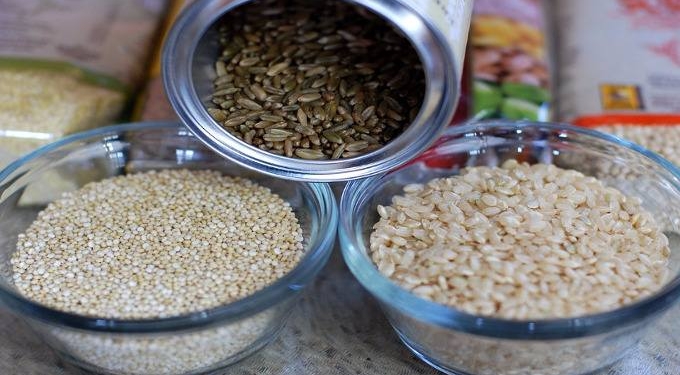
By Heather Poole | Lifehack
Quinoa is renowned as a Superfood, or a nutrient-rich food especially beneficial for health and well-being, not only for the health benefits, but for it’s versatility. But is another Superfood waiting in the wings to take the spotlight?
As it turns out, yes. Freekeh is steadily gaining popularity, and for good reason. Before we go deeper let’s look at what freekeh is actually first.
Freekeh (pronounced free-kah) is the result of wheat harvested while young and green. It’s roasted over an open fire and the straw and husks of seeds are burned and rubbed off. The grain on the inside is too wet to burn, so you’re left with a firm, mildly chewy grain with an earthy, smoky flavor[1].
The Great Debate: Freekeh VS Quinoa
Why eat Freekeh? Why eat Quinoa? Should you favor one over the other? Each is packed full of of nutritional goodness, but how do they compare to each other?
Quinoa is a gluten free grain, making it a great choice for the many people who suffer from gluten allergies. Freekeh is not gluten free, as it is a type of wheat. It makes up for the gluten when it comes to protein and fiber content, since Freekeh has nearly double the amount of fiber and protein that quinoa does. This may result in weight loss for those adding it to a healthy lifestyle. For those living with diabetes, Freekeh is also the better option – it ranks at a low 43 on the glycemic index, whereas quinoa is higher at 54.
Let’s break down the additional nutritional components of Freekeh and Quinoa in the table below, using 100 grams of each as the serving size:
Freekeh[2]
- 353 calories
- 60.8 grams carbohydrates
- 14.9 grams protein
- 2 grams fat
- 12.9 grams fiber
- 31 milligrams zinc (207 percent DV)
- 32 milligrams iron (178 percent DV)
- 3.4 milligrams copper (170 percent DV)
- 370 milligrams calcium (37 percent DV)
- 110 milligrams magnesium (28 percent DV)
Quinoa[3]
- 120 calories
- 21.3 grams carbohydrates
- 4.4 grams protein
- 1.9 grams fat
- 2.8 grams fiber
- 1.09 milligrams zinc (10 percent DV)
- 1.49 milligrams iron (19 percent DV)
- 0.19 milligrams copper (21 percent DV)
- 17 milligrams calcium (2 percent DV)
- 64 milligrams magnesium
Freekeh-Out: Numerous Health Benefits of Freekeh
Freekeh is truly worthy of being called a Superfood, even if all you know about it is its nutritional value. But it isn’t just good for getting in your vitamins — Freekeh also carries amazing digestive benefits.
- Because of its fiber content, it can ease a number of common digestive complaints including diarrhea and constipation. This is huge, especially considering the number of people affected by digestive issues in the U.S. alone in 2010 was 70 million people[4].
- The fiber content in Freekeh can also aid weight control management, since it helps avoid snacking between meals due to feeling fuller longer. It contains three times as much fiber as brown rice, so there’s a good chance your stomach won’t be grumbling hours before your next meal!
- Along with fiber, Freekeh also contains loads of antioxidants which can positively impact eye health. This is thanks to the antioxidants called zeaxanthin and lutein. These are known to prevent macular degeneration which typically occurs as we age.
- Freekeh even aids muscular growth and endurance, thanks to an amino acid called glutamic acid. This is popular with bodybuilders and athletes, as it assists with improving strength and endurance, naturally.
- And as mentioned earlier, the wholegrain variety of Freekeh ranks low on the glycemic index, making it ideal for anyone trying to maintain their blood sugar levels. Even if you aren’t diabetic, healthy blood sugar levels are important, as out of control levels can lead to heart, kidney, eye and nerve damage[5].
While it sounds too good to be true, Freekeh really is as great as it seems, and easily attainable! Whole Foods Market and Trader Joe’s sell Freekeh, and Whole Foods’ website even offers a few recipes. But if you’re like me and prefer doing as much of your shopping online as possible, Amazon is also a great resource to purchase a variety of Freekeh, some options even offering bulk quantities.
I’ve bought it, now what?
Aside from gluten and calories (which do not impact everyone the same way depending on lifestyle and allergies), Freekeh offers much more than Quinoa. But what does it taste like? Sure, it’s kind of smokey and earthy, but that probably rules out adding cinnamon and milk and making it a breakfast. Nope! As it turns out, it’s incredibly versatile.
















